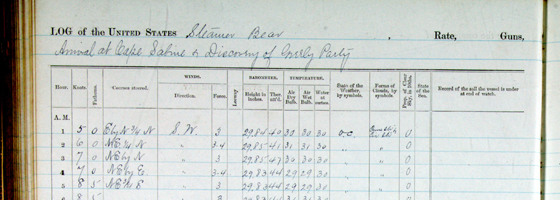Climatologists turn to ship logs, volunteer transcribers for historic Arctic climate data

A collaboration of citizen science groups, online cooperatives, and government agencies has created an initiative that allows citizens to get a look at history while helping Arctic climatologists understand the present and predict the future.
The group created an online transcription program that gives citizens the opportunity to go through logs from U.S. Navy, Coast Guard and Revenue Cutter ships that traveled to the Arctic between 1850 and World War II.
Zooniverse, a web service dedicated to citizen science projects, hosts the transcription program on www.OldWeather.org. The public can log on, read and record Arctic weather information from ship logs as part of a communal effort.
Kevin Wood, NOAA’s principle investigator for the Old Weather project, said he’d been working for years to reconstruct climate history of the Arctic when he found a group that was transcribing ship logs to document historical weather across the world.
“Knowing we have, in the National Archives, a vast collection of similarly hand-written marine meteorological records in historic ship logbooks we set off to build Old Weather-Arctic,” said Wood, a climate scientist at the NOAA Joint Institute for the Study of the Atmosphere and Ocean at the University of Washington.
The logs offer comprehensive information on weather and sea conditions, from barometric pressure and wind direction to temperature and anecdotal atmospheric information.
Log notes also share historical information on who was riding the ship or interesting events that transpired while aboard. Wood said one interesting nugget found was documentation of Roald Amundsen, a Norwegian explorer who was the first to reach the South Pole in 1911. Bits of information from several ship logs mentioned Amundsen. Different logs accounted for Roald Amundsen riding on board as a guest of the captain, steaming through scattered wreckage in thick fog and running down a convoy at first light to find three ships missing. “But those stories are for the Old Weather volunteers to bring out in full,” Wood said.
While scientists and archivists value the ship logs, they can’t possibly transcribe them all themselves. There are too many logs and there’s too little time. A public transcription effort accomplishes ship log documentation considerably faster than a few archivists could ever work. For example, since 2010, more than 16,000 volunteers transcribed 1.6 million weather observations in Old Weather’s initiative to transcribe British Royal Navy logbooks, according to a NOAA news release.
So far, Old Weather-Arctic has 100,000 pages ready for transcription.
The transcription interface created for the project is easy and straight forward. Each logbook page is scanned as digital image. Users highlight information with boxes drawn on the documents and fill in information fields with data they see on the page
Wood said any significant discovery unearthed while transcribing will be credited to person who found it. “The Old Weather citizen-scientists are considered full partners in the project and, if desired, will be credited for making any discoveries and included on publications,” Wood said.
For skeptics who question the validity of citizen transcribing, a system is in place to ensure the information is accurate. “Every page is independently transcribed three times to control transcription error. This results in transcription accuracy of 98 percent,” Wood said. “The data are then subjected to a range of statistical and logical tests to flag outliers and identify other errors as in wrong hemisphere or 95 degrees north.”
Recent news of a quickly changing Arctic with record ice melts make understanding the historical weather of the ice caps relevant and important, especially to those trying to understand long term trends. “The Arctic sea ice is going away faster than expected. Why this is happening isn’t well understood and knowing more about how the sea ice has varied in the past will help us find out why,” Wood said. “Getting a good handle on these things will help us improve climate and forecast models and improve future projections.”
Top image: A page from the log book of the U.S. Navy steamer Bear, June 22, 1884. The Bear’s logs are included in the Old Weather-Arctic citizen science project. (Credit: National Archives)





0 comments